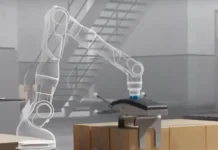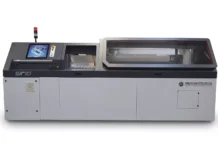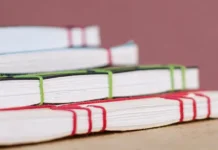by Brittany Willes, editor, PostPress
Perfect binding and PUR binding – they’re essentially the same process, aren’t they? Actually, no. PUR binding refers to a method of perfect binding that has become increasingly popular in the last few years. As with traditional perfect binding, a book’s pages and cover are glued together at the spine while the three remaining sides are trimmed to give them the classic “perfect” edges. However, there are a few notable differences between the two methods.
With decades of industry experience, Eckhart & Company, Inc., Indianapolis, Indiana, is more than familiar with the challenges faced by printers and binders looking for the most effective method for binding a given project. When it comes to deciding between traditional perfect and PUR binding, Chris Eckhart, president of Eckhart & Co., offered the following information:
How is PUR different from perfect binding?
For sure there are differences between the two binding methods, even if it doesn’t appear that way at first glance. It all comes down to the adhesive used during the binding process. The biggest difference between PUR and perfect binding is that traditional perfect relies on ethylene vinyl acetate (EVA) adhesives, while PUR makes use of polyurethane reactive (PUR) adhesive.
Book spines that make use of PUR are prepared in much the same way as a traditional EVA-bound book, utilizing a variety of notching, roughing/equalizing heads in order to create fiber. The adhesive then will bond with these fibers during the curing process. The properties of PUR adhesive are designed in such a way that they draw moisture out of the air as part of the curing process. The amount of paper fibers also is reduced with PUR.
Why opt for PUR instead of EVA binding?
One of the biggest advantages of PUR is that it offers significantly increased binding strength. Once the adhesive has set, page pull tests are often up to 50 percent stronger than with books that use EVA glue. It also offers greater aging stability, is impervious to print ink oil migration and is capable of bonding to coated and cross-grained stock. Furthermore, PUR is extremely durable. This is particularly helpful in that it is not susceptible to issues brought on by extreme temperatures, like traditional perfect binding can be.
As with conventional hot melt glues, the initial bond in PUR is formed as it cools and solidifies. Unlike conventional hot melts, PUR contains reactive components (isocyanate groups), which cure in the presence of humidity and form a strong elastomeric film. Furthermore, while EVA’s properties allow it to be reactivated with heat, the film produced by PUR cannot be re-melted and is insoluble to most solvents. Thus, EVA binding exposed to extreme heat is able to melt, while a PUR binding will remain in its solid state. Typically, PUR has a heat resistance of 350°F peel failure, compared with 165°F to 200°F for quality EVA. Extremely cold temperatures provide additional problems for EVA, mainly that it is subject to cracking and brittleness. Again, because PUR cannot be reactivated, it is in no danger of cracking. Typical cold crack for PUR measured at -20°F vs. 30°F for EVA.
How does PUR achieve its flexibility?
As mentioned earlier, once the adhesive is set, it is extremely difficult to pull pages from a PUR-bound book. The adhesive cannot be reactivated, giving it increased durability. This might seem like it would make the binding less flexible, but that’s not the case.
PUR uses a much thinner application of adhesive than compared with EVA (10 to 12ml vs. 25 to 35ml per EVA). This thinner application of adhesive, along with its reactive properties, is what gives PUR its flexibility. In testing, PUR has extremely high flex-test values, often in excess of 1,000 flexes. It is this flexibility that allows also for greater lay-flat characteristics. When applied properly, PUR’s lay-flat ability is comparable to that of true Otabind. Additionally, a thinner application frequently will improve performance and result in improved “mileage” over time. With less adhesive on the spine, there is less distortion of shape and cleaner overall appearance.
What are some challenges associated with PUR binding?
PUR is applied using an open roller pot system and, while this system does have advantages – such as better accessibility for operators and providing greater consistency of application with thicker books – it also can be costly in terms of maintenance and cleaning.
The one-pot system requires a longer cleanup process than traditional EVA systems. The pot must be drained and the adhesive allowed to cure overnight before the pot can be reheated and any remaining adhesive removed. The adhesive pot may require recoating as often as once every three years. The system also allows for greater amounts of glue spoilage.
When it comes to maintaining a one-pot system, it’s best to check with the equipment manufacturer for guidance on best practices. The technology does exist to apply (essentially spray) PUR onto the binding edge using slot-nozzle technology. This technology has advantages and disadvantages – the biggest advantage being the cleanup is not nearly as extensive as it is with an open pot system.
Are there times when PUR adhesive is not preferable to EVA?
In almost every situation, PUR is better than EVA. There is one exception, however: If a book block is being bound or prepared for case binding, the spine can’t be rounded in the casing-in process if PUR is used. In this situation, EVA has a tad bit more roundability/flexibility.
PostPress would like to thank Chris Eckhart, Eckhart & Co., and Matt Worley, BC Adhesives, for their assistance with this article. Eckhart & Co. has spent decades providing the printing industry with bookbinding and custom information packaging. Based in Franklin, Wisconsin, BC Adhesives combines its technical expertise with ongoing, proactive support to ensure its customers are utilizing the most efficient consumption practices to help customers maximize the efficiency of each application.





